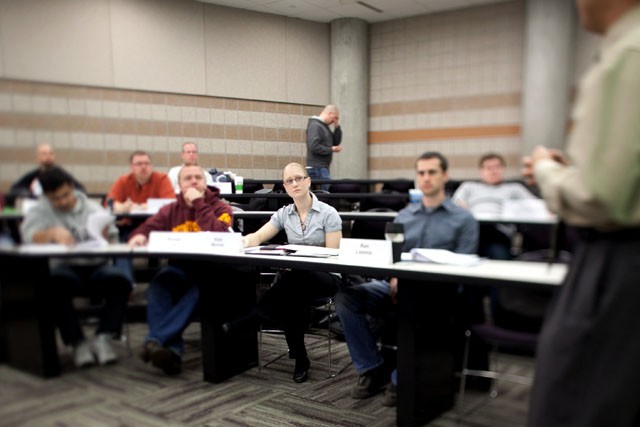The Carlson School of Management ranks in the top-five schools nationwide for enrolling female students in its MBA programs. But a survey of international applicants and admission test data shows it is well below its potential for attracting women.
The survey, by London-based Quacquarelli Symonds, an education media firm, found 37 percent growth in the share of female MBA applicants worldwide in the last five years.
During the same period, the number of women who applied to Carlson SchoolâÄôs part- and full-time programs seesawed, Part-time enrollment dropped from 34 percent in 2004-05 to 27 percent in 2009-10, and full-time numbers rose from 27 percent in 2005 to 30 percent in 2010.
That puts the schoolâÄôs share of female applicants well below the 48 percent the QS survey cites.
Daniel Bursch, admissions and recruiting director at Carlson School, said it doesnâÄôt have a policy to increase its share of female applicants. Instead it focuses on improving the overall environment for businesswomen.
âÄúWe look on a higher level,âÄù he said, listing as proof the schoolâÄôs chapter of the National Association of Women MBAs, a partnership with the Forté Foundation, a group promoting women in business leadership, and its hosting of the annual WomenâÄôs Leadership Conference, which runs later this month.
Jill Haspert, president of NAWMBAâÄôs Carlson School chapter, agrees with the holistic
approach to improving womenâÄôs lot in business over a focus on parity in the classroom.
To that end, NAWMBA members help each other network and search for jobs and internships. The group also holds educational and service events.
âÄú[ItâÄôs] kind of like you have each otherâÄôs backs, if you will,âÄù she said.
Haspert acknowledged that the gap is palpable but said it was minimal.
âÄúFrom a day-to-day perspective, itâÄôs not really a huge difference.âÄù
Bursch said data from the Graduate Management Admissions Test, the prerequisite for admission into U.S. business schools, which shows a more modest gap, is more comparable to Carlson School than the international QS report.
The female share of GMAT takers rose from 39 percent to 40 percent over the five-year period from 2004-05 to 2009-10. It has held steady over the last decade.
That Carlson School âÄî where the accepted class roughly mirrors its applicants, Bursch said âÄî ranks among the top nationally while sitting 10 points below the GMAT rate signals a gap between women applying and getting accepted.
âÄú[Women] tend to drop out in higher numbers than men during the application process,âÄù said Ross Geraghty, editor of Quacquarelli SymondsâÄô MBA site.
Accounting for the gap, Bursch cited the broader business environment.
âÄúWeâÄôre a byproduct of what the business community is,âÄù he said, adding that while they have âÄúchanged significantly,âÄù traditional gender roles persist to a degree, as do some differences in value each gender places on work.
Haspert said having more high-profile women in corporate America would drive up application rates. Women ran just 15 of the Fortune 500 companies in 2009, according to a report by Fortune magazine.
Despite the precipitous gap in the business world, Bursch said the academic climate is changing, though he canâÄôt predict when women and men might hold the same number of seats in business classes.
âÄúIn general, the trend is rising,âÄù he said. âÄúWill we ever get there? I donâÄôt know.âÄù

Graduate student Katy Morlok attends Data Analysis and Statistics for Managers of the MBA program Saturday morning in the Carlson School of Management. While 40 percent of GMAT test takers were women, 30 percent of Carlson’s MBA students are women.
Carlson’s women applications seesaw
The school’s level of women applicants has fluctuated while nationally, the rate has increased.
Published April 5, 2011
0

